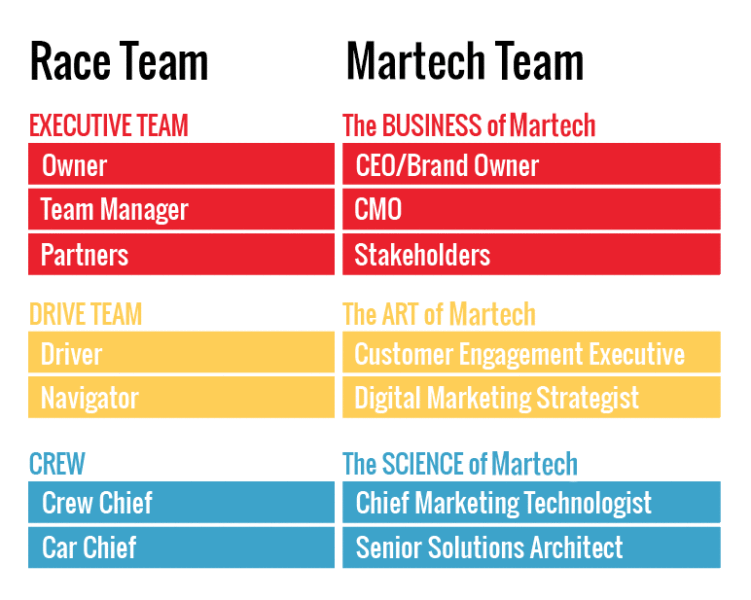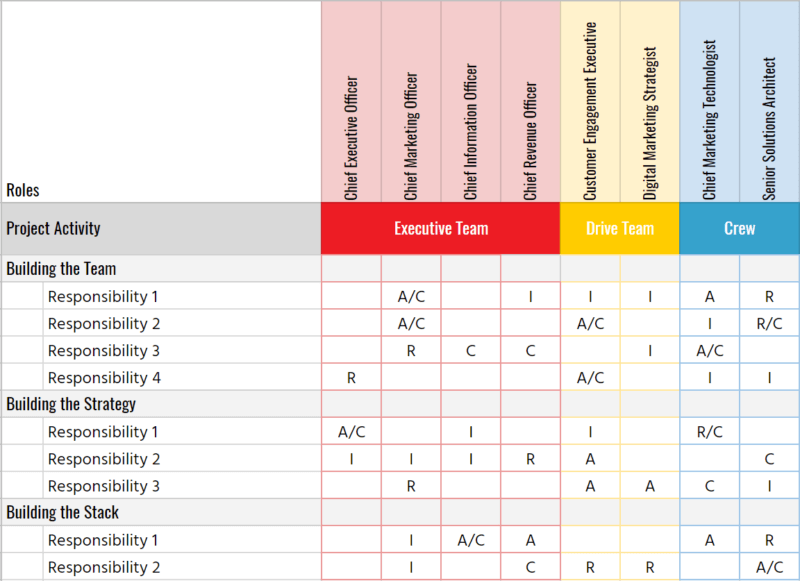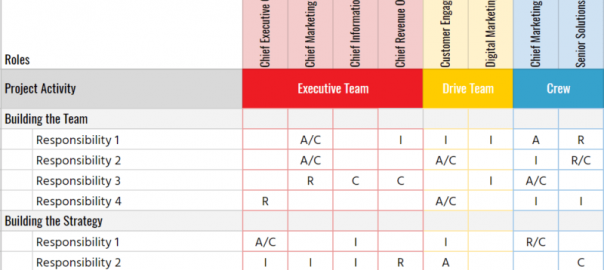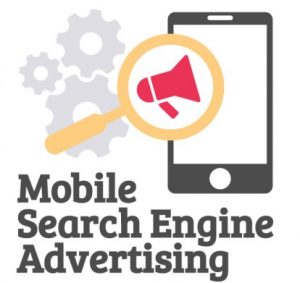In Part 4 of a nine-part series, contributor Peter Ladka takes a look at how to identify roles and responsibilities, and how to educate and train your team to successfully move your organization towards martech enablement.

Image credit: Abdul Razak Latif / Shutterstock.com
Welcome to Part 4 of “A Nine Part Practical Guide to Martech Enablement.” This is a progressive guide, with each part building on the prior sections and focused on outlining a process to build a data- and technology-driven marketing organization within your company. Below is a list of the prior articles for your reference:
In this part, “Building the Team,” we will look at ways to evaluate the state of your current organization and some simple steps to begin the process of martech-enabling your team members and partners to create a winning team.
Building the team

In Part 3, we spent the vast majority of our time discussing the core team of a successful martech-enabled organization. This included the groups they are in, the roles themselves, and how they correspond to a winning race team.

As we proceed, we’re going to look at the key steps in the process that lead teams to achieve enablement:
- Create a martech vision for their enablement initiative and team.
- Get executive management buy-in.
- Identify team roles and responsibilities.
- Who, where, what? Filling the roles with individuals.
Creating an environment of agility, education and collaboration is necessary to foster a strong, cross-functional team. This team must also prepare for a constant state of incremental change and growth.
Creating a martech vision
It seems intuitive to say that breaking down silos within your organization is a good thing. But nothing will stunt or kill a company’s martech enablement efforts more than allowing a traditional organizational structure to present barriers to the collaboration necessary for martech success.
The CMO (team manager) must envision his or her martech team as a cohesive unit, with its most important task being to create a common vision for martech enablement across organizational silos. Envision your martech enablement team as a unit, regardless of where each team member sits within your corporate structure.
I find it helpful to suggest to CMOs that they actually write a brief vision statement for their martech enablement effort to use as a target with which to evaluate ongoing trajectory. Remember, martech enablement isn’t a destination; it’s a journey that will continue as long as there’s work to do in the areas of customer engagement and as long as technology continues to progress (which we can agree are both ongoing).
Executive team buy-in
It’s been my experience that a CMO who has the support of the CEO (owner) will have the easiest time building a cohesive martech team. Forward-thinking CEOs or brand owners are often already aware of the value of martech enablement.
Just recently I was visiting with Jack Lynch, CEO of Houghton Mifflin Harcourt. HMH specializes in pre-K-12 education content, services and technology solutions for today’s changing landscape. During our conversation, he said, “Having a data-driven marketing organization is critical to meeting and exceeding our customer expectations by providing them the right content at the right time.” It’s this type of insight and visionary thinking from CEOs that enables CMOs to rapidly take advantage of martech enablement.
Other times, the CEO may be unaware of the changes in marketing and technology. Those CMOs must make a business case to their CEOs to help them understand the need for martech enablement to stay competitive and focus on the customer experience. When a CEO is behind the idea of martech enablement, the CIO (chief information officer) and CRO (chief revenue officer) are the next critical executive team members to build synergy with.
With the emergence of martech, the marketing organization is being transformed into a revenue-centered division of the overall organization. The same can be said for martech’s impact on the CIO’s responsibility. Removing the silos between marketing and technology through a common interest of revenue impact is a compelling objective that few CIOs I’ve met will resist.
The partnership between the CMO and CRO (or whatever the executive over sales is called in your company) should also be a primary focus when it comes to executive buy-in. Part of martech enablement overlaps with a sales enablement focus in your organization. Creating sales-qualified inbound opportunities will more than likely be a primary objective of your marketing organization.
Additionally, marketing-supported sales customer journeys will be a part of your marketing strategy. Common objectives around these activities are best supported by a strong cross-functional sales and marketing department led by the CMO and CRO.
Identifying roles and responsibilities
To ensure that you and your core team have a common understanding of each area of responsibility within the marketing organization, a healthy exercise is to define and outline those responsibilities by role. This also ensures that all of the critical areas of need have sufficient and mutually understood coverage. And tasks that are critical to the successful creation and execution of your martech-enabled organization won’t fall through the cracks as a result of lack of ownership or diffusion of responsibility.
I recommend you identify roles and responsibilities first, without consideration for current staff or partnerships. Base this exercise on what your martech organization will need to be successful. There’s always the temptation to look at existing staff while performing this effort. In a later step, we’ll look at evaluating your current staff and partners for assignment of roles and responsibilities.
Many tools are available to help you create this outline. One of my favorites is the RACI matrix. Much has been written about RACI so I won’t go into depth, but it allows for the graphing of the intersection of roles and responsibilities and the assignment of four designations for a role against a responsibility. Those four designations are:
- Responsible — Performs the activity/task
- Accountable — Ultimate owner with Yes/No authority
- Consulted — Supplies insight or opinion before and during the activity
- Informed — Provided result of progress/outcome
Once the roles and responsibilities have been graphed on the matrix, you assign one or more of the following designations at the intersection. Below is a simple graphic to demonstrate what a RACI matrix could look like.

At this point, your RACI matrix will largely consist of the roles in your core team, but you may also include any known specialist roles as described in Part 3 of this guide. The RACI matrix will need to be revisited later after Part 5, “The Team Strategy — Defining the Strategy” as additional specialist roles will often emerge during that step.
As you mature in martech enablement, understanding it’s an agile and ongoing process, it’s a good common practice to revisit your RACI matrix regularly (perhaps quarterly, but at least biannually) to ensure that as your marketing organization evolves, there continues to exist a common understanding of roles and responsibilities.
Who, where, what?
Now that the roles and responsibilities exercise is complete, the next step is to examine your existing staff and partners and how they align with the established structure. With the metamorphosis that’s transpired in marketing over the past few years, most, if not all, of your existing staff will have an understanding of the influence that martech has on marketing and the importance of being agile as the team makeup transitions.
Outside help
Although many of the roles in your team — both core and specialist — will be part of your staff, it’s normal for a martech enablement team to be made up of both inside and outside help. A good martech enablement company can provide strategic support for kicking off and continuing to mature your martech initiatives, as well as tactical specialist support during execution.
As a strategic and tactical note, I find it very rare that the “driver” role of Customer Engagement Executive is filled by an outside partner. Digital agencies can be well-suited to be part of the “Drive Team,” including the Digital Strategist role, as well as many of the specialist roles like creative, content creation, research and analysis. But the driver, in my opinion, must be a member of the organization’s staff.
Conversely, the role of “Crew Chief” or Chief Technologist can be and is often filled by a strong strategic technical partner. This technical partner can also fill the “Car Chief” or Senior Solutions architect, as well as any or all of the crew’s specialist roles, such as marketing technologists, implementation specialists, data scientists and analysts, security specialists and dev-ops.
Managing change
Look at any shifts among your marketing organization’s staff with a mind for good change management, training and education. Resist the urge to significantly modify your roles and responsibilities to fit existing personnel.
Instead, focus on helping them adjust to their new responsibilities. Deliberate, managed change provides the best opportunity for your team and its members’ success. Some key elements to remember are to:
- create a plan for the change.
- consistently communicate the end goal.
- set achievable and realistic objectives.
- manage your expectations.
- hold people accountable for their part in the change.
Conclusion
Following the four steps mentioned in this article will set you on the right track to building your martech enablement team. These steps will be ongoing as marketing and martech continue to mature. Creating an agile and flexible team will help you continue to remain competitive in this ever-growing and transitional space of martech enablement.
Intro to Part 5: The team strategy
In Part 5 of the “Martech Enablement Series: A Nine Part Practical Guide to Martech Enablement,” we will begin to outline the process of defining the overarching martech strategy that will provide guidance and a common purpose for your martech team.
I look forward to continuing to share about martech enablement with you in Part 5 of this guide.
Some opinions expressed in this article may be those of a guest author and not necessarily Marketing Land. Staff authors are listed here.
Marketing Land – Internet Marketing News, Strategies & Tips
(226)
Report Post








